Su-25 attack aircraft in Afghanistan
The need for Su-25 was very great, and the 28 arrived on April 1981 in Sital-Chai, Deputy Chief of the Air Force A.N.Efimov set the task: to urgently prepare for work in the DRA a squadron of the available vehicles and pilots who mastered them. The commander of the 200 th separate assault air squadron (OSHAE) was appointed deputy regiment commander for flight training AM Afanasyev. To speed up the retraining, test pilots and instructors from the Lipetsk Center for Combat Training of the Air Force, a “high school” of military pilots, were attracted, and part of the testing and tuning of the onboard equipment of the still half-baked vehicles was conducted at the RI Air Force test site.
19 July 1981. 200 Squadron, whose work was coded with the name Operation Exam, arrived at the DRA. Shindand was chosen as the base - a large airbase, which had already been run through Su-25 during tests of 1980. Shindand was located in a relatively quiet area compared to the central and eastern provinces, and among other Afghan airfields was considered lowland - its almost three-kilometer concrete was located at an altitude of 1150 m and was more than sufficient for Su-25.
The Shindand air base attack planes were to be supported by the Soviet 5 motorized rifle division stationed in these places, which was then commanded by Colonel B.V. Gromov, the paratroopers of the 103 division and the 21 th infantry brigade of government forces. The combat work of the Su-25 started within a few days after arrival. At this time, there were battles for the Lurkoh massif not far from Shindand — an impassable heap of rocks that rose up among the plains and occupied several dozen square kilometers. In the nature of the fortress created by itself, there was a base camp, from where spooks made raids on nearby roads and attacked military posts. The approaches to Lurkoha were defended by minefields, rock and concrete fortifications, literally every break in the gorges and the path was covered by firing points. Using the invulnerability, the enemy began to use Lurkoh and as a command post, where the leaders of the surrounding gangs gathered. Repeated attempts to capture the mountain range were not successful. The command decided to abandon the attacks "in the forehead", going to the daily heavy bombardment and shelling, which would have forced the enemy to leave the lived-in camp. Outside, Lurkokh was surrounded by dense minefields, and the passageways and trails inside the massif were also periodically covered with mines from the air.
To assess the effectiveness of the attack aircraft, a military pilot Major-General V. Khakhalov arrived at the DRA. He was instructed by the Commander-in-Chief of the Air Force to personally evaluate the results of the Su-25 strikes. After the next raid, a pair of Khakhalov helicopters went deep into Lurkoha. Back the general has not returned. The helicopter with him was shot down and fell near the base of the dushmans. The death of Khakhalov forced to change the course of the operation - the paratroopers, who had made their way to the center of the fortified area, were thrown into the assault on Lurkokh in order to collect the bodies of the general and the pilots who were killed with him. After a week of fighting, costing the lives of eight more people, the troops occupied the base, blew up its fortifications and, once more mined the entire area, left it.
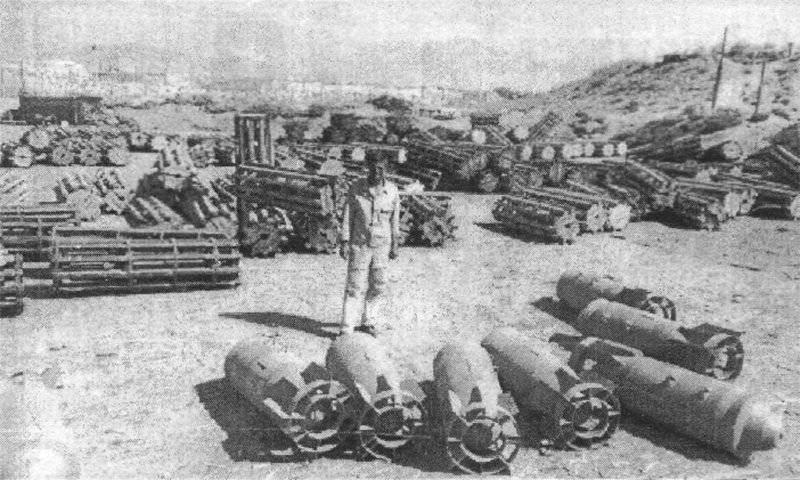
The 200 th OSHA attack aircraft also participated in the struggle for Herat, located 120 km north of Shindand and became the center of the opposition in the west of the country. The local gangs acted directly in the city, dividing it into spheres of influence and fighting not only with government forces, but also among themselves. There were also strongholds, stocks weapons and ammunition. Su-25 had to strike right in the city at dushman-controlled quarters and houses indicated by intelligence. There was plenty of work in the vicinity of Herat - the endless green zone and the adjacent valley of Heriruda. Numerous kishlaks who served in the provinces of Herat and Farah were supported by detachments that supplied the Mujahideen with food and recruitment. Then they found rest and overnight, getting weapons from nearby bases in Iran. The most prominent of the local commanders was Turan Ismail, a former army captain who switched to the Mujahideen after the April revolution. Military experience, literacy and rigor quickly allowed him to become a local emir, in whose power there were seven provinces and an army of five thousand militants. Under the cover of "Zelenka" - extensive thickets of bushes, orchards and vineyards - the Mujahideen were selected to the location of military units, robbed and burned convoy, and after the attacks instantly dissolved in the surrounding villages, and finding them in these places, especially from the air, was no easier than in the mountains.
In the air above the valleys, a dusty mist constantly hung up to the 1500, worsening visibility and hiding landmarks for several kilometers. During the season of dust storms and the hot "Afghan" that flew out of the desert, there was no escape from it anywhere, and from the hatches and hoods of the returning attack aircraft, sand was gathered in handfuls. It was especially difficult for the engines - sand, like sandpaper, gnawed the blades of compressors, and the heat that reached + 52 ° made it difficult to start. To help the strangled starter, quick-witted aviators used a kind of evaporative cooling, throwing a couple of water into each air intake. There were cases when the APA plug tightly burned to the onboard electrical connector. In a hurry, the cable was cut with an ax lying at the ready, and the plane flew away with hanging wire fragments. The search for the enemy took time, and to increase the duration of the flight, most of the tasks had to be performed with a pair of suspended tanks PTB-800 (Su-25 was conceived for work in the front-line, and with a supply of fuel in the internal tanks, its radius did not exceed 250-300 km).
From September 1981, the planned hostilities began in the south of the country in Kandahar, which was also the responsibility of 200-OSHA. The second largest city in Afghanistan, the ancient center of trade and handicrafts occupied an important strategic position, allowing to control the entire southern direction. The main roads and caravan routes, including the only highway in the country that connected all major cities and the horseshoe girdled the country, passed through Kandahar. The proximity of Kandahar to the Pakistani border was also attractive to the Mujahideen. The 70-I motorized rifle brigade of the Soviet contingent, sent to Kandahar, was immediately drawn into endless fighting, on which the situation on the roads and the situation in the city itself depended. Numerous detachments, which settled in the "Zelenka" around the city, sometimes blocked the garrison for weeks, not letting a single vehicle into Kandahar. From the north, the mountains of Maiwanda were approaching Kandahar, where the strongholds of the Mujahideen served as fortresses, preserved from the times of the wars with the British.
High mountain maneuverability of the Su-25 was especially useful in mountain gorges. Crossfire from the heights turned the foothills into a trap for the soldiers who entered them, it was not always possible to pull artillery there and Tanks, and attack aircraft came to the rescue. The Su-25 dived into narrow stone bags, where other planes did not dare to descend, approaching the target along the gorge or, if width allowed, sliding down along one slope and literally crawling out of the attack in another. In the Black Mountains northwest of Kandahar, one of the pilots of the 200th OSHA in October 1981 managed to suppress a firing point hidden in the rocks at the end of a long winding gorge. Attempts to bomb her from above did not bring success, and the Su-25 had to go into a dark failure, maneuvering, zipping over it and, delivering an exact blow, stepping out with a sharp combat turn.
The small turning radius of the Su-25 (450-500 m) helped the pilots to build an attack: after detecting the target, it was possible to immediately roll on it, and when re-entering, to turn, not losing sight of the enemy, and finish off, economically spending ammunition. The pilots of the speed Su-17 and MiG-21, turning around for the next strike, often could not find the target again, "without clear demasking signs."
Due to the large wing area and powerful mechanization, the Su-25 differed favorably from other cars with good take-off and landing qualities. Stormtroopers with a maximum combat load up to 4000 kg (8 FAB-500) were enough for a takeoff of 1200-1300 m, while based in Shindand, Su-17 had a ton of bombs off the ground only at the very end of the strip. The "twenty-fifths" suspended armament included NAR, RBC, high-explosive and fragmentation bombs. In the valleys, 100- and 250-kg bombs were used more often, enough to destroy the clay structures; in the mountains, which were abundant in natural shelters, the “five hundred” high-explosive power became necessary (they were more often used in “winter” equipment variants, when, with cooling, the engines could develop full thrust). In the green areas and villages where there was something to burn, incendiary tanks and bombs were used. The gasoline and kerosene mixture thickened for stickiness of a half-ton tank ZB-500GD covered the area with a fiery carpet 1300 square meters, and the ZAB equipment, in addition, included a rag soaked in fire mixture that scattered around and caused many new fires.
High-explosive high-explosive NAR C-5M and C-5MO from 32-charging units UB-32-57 were widely used. In one gulp, they covered up to 200-400 square meters, depriving the enemy of one of the most important advantages - the ability to hide and quickly disperse in the terrain. An 2-3 launch was usually made at a target, launching rockets from a dive at 8-12. In flight with blocks, a significant increase in resistance should have been taken into account: when the four UB-32-57 were suspended, the attack aircraft obeyed the rudders worse, sagged at the exit from the dive, losing altitude and speed - a feature that was not found when using bombs, since their discharge immediately released the aircraft for maneuver.
Small-bore NAR was gradually replaced by more powerful 80-mm C-8, used in different versions: C-8M with enhanced fragmentation effect, C-8BM with strong heavy warhead crumbling rocky gun emplacements and walls, and C-8DM containing liquid explosives, from which the enemy was not saved by any shelters - after a missile strike, the mist of explosives covered the target, climbing into the back streets of villages and mountain crevices, hitting the most secluded places with a continuous cloud of explosion. The “crows” had the same effect - the volume-detonating bombs of the ODAB-500P were three times more powerful than the fugaski equal in caliber. The deaf cotton of an explosion of such ammunition was swept away by buildings in the radius of 20-25 m, wilderness and blowing away all life on hundreds of meters around with a red-hot shock wave. Objectives for the ODAB had to be picked up only in the valleys — an explosion in the thin air of the highlands lost its force. In the heat or strong wind, when the explosive cloud quickly lost the concentration necessary for the explosion, they used a “cocktail” - a combination of ODAB and smoke bombs, the thick smoke of which did not allow the aerosol to dissolve. The most effective was the ratio: a pair of DAB-500 to six ODAB-500P. Space-detonating ammunition was widely used, preparing landing sites for helicopter landings - suitable landing sites could be mined, and attack aircraft thus cleared them, causing detonation of mines over a large area.
Pilots' favorite weapons were heavy NAR C-24 with high accuracy characteristics (with 2000 m missiles fit into a circle with a diameter 7-8 m) and powerful high-explosive fragmentation action, which was well suited to combat a variety of goals. In machine gun nests and Dushman caravans, attack aircraft fired from an onboard cannon GSH-2-30, which had a high rate of fire and a powerful projectile. The instruction recommended firing short one-second 50 bursts of armor-piercing-explosive and high-explosive fragmentation shells (the mass of such a volley was 19,5 kg), but the pilots tried to shoot the target "with a guarantee" by flipping it over with a long burst, and often after 2-3 clicks on combat button remained without ammunition.
On the flat terrain, the ASP-17БЦ-8 automatic sight, which was used for firing from a cannon, launching rockets and bombing, showed itself well. The pilot only needed to hold the object of attack in the mark of the sight, whose automation using a laser rangefinder took into account the distance to the target, and also made corrections for altitude, speed, air temperature and ammunition ballistics, at the right moment giving the command to drop bombs. The use of TSA gave very high-quality results, and the pilots even argued among themselves for the right to fly an attack aircraft with a well-adjusted and well-adjusted sight. In the mountains, its reliability decreased - with a sharp difference in altitude and difficult terrain, the sight calculator could not cope, “losing its head” and giving too many blunders. 3 of these cases had to be fired, using the TSA as a normal collimator sight, and dropping bombs “at the behest of my heart”.
Respect for the pilots deserved the well-thought-out protection of the systems, main units and the Su-25 cockpit. Her titanium armor and frontal armored glass could not penetrate the bullets of small arms and DShK, and on the sides of the Su-25 there were traces of smeared bullets. The attackers kept the strike well - the plane of A. Lavrenko, having received an anti-aircraft missile at the tail end over the Panjsher, flew with an almost completely broken control gear, which left less than 1,5 mm of metal. Major G. Garus was able to reach the aerodrome and, on his car, DShK's bullets pierced the engine and completely damaged the hydraulic system.
Along with 200-OSAE, a team of factory specialists and OKB employees constantly accompanied the operation (in fact, Su-25 troop tests) and carried out the necessary changes and improvements in place, primarily to expand flight restrictions. During the 15 months of operation, the 200 th OSHA attack aircraft, having completed more 2000 sorties, did not have combat losses, but in December 1981 due to exceeding the allowable dive speed, Captain A.Dyakov crashed (the situation aggravated the bomb dropping from one extreme pylon, after what the plane pulled into a roll, the pilot failed to level the car, and she, sliding on the wing, crashed into the mountainside). Under the same circumstances, G. Garus almost died, but this time the pilot had enough height to pull out. Another Su-25 was lost due to the fact that they forgot to charge the hydroaccumulator on the ground, and the landing gear could not get out, the temperature behind the turbine rose, threatening to fire, the heavily loaded aircraft began to “crumble” down, and the pilot had to eject. The pilots also noted the lack of effectiveness of the air brakes, which did not have enough surface area when diving - the Su-25 continued to accelerate, losing stability and trying to roll backwards. These deficiencies were eliminated in the subsequent series of aircraft: they introduced boosters into aileron control, a duplicated mechanical turn of the front landing gear wheel to enable “foot” control when taxiing, refined the fuel system and increased engine life. Due to the strong recoil of the cannon during firing, it was necessary to strengthen the attachment points of the gun and the “cracking” structural elements. Made a lot of minor operational improvements, simplified and accelerated the preparation of the aircraft, and on the side caused bright stencils, reminiscent of its order.
The disadvantages of the aircraft include the low reliability of a part of radio electronics and, first of all, the automatic radio compass ARK-15 and the RSBN-6C navigation radio system. When performing tasks, one had to choose a plane in the squadron with more or less well-adjusted equipment, which served as a leader for the whole group. The gun was the real enemy of onboard electronics - powerful shocks when firing now and then led to failures of the REO.
According to the results of the “Exam” operation, the large labor costs for the Su-25 armament equipment were noted. Recharging 250 ammunition to the gun took 40 minutes for two gunsmiths and was very uncomfortable: they had to work on their knees, tucking a massive ribbon in the compartment overhead. Ground-based security has always been considered a secondary issue (although it is difficult to attribute to the flaws of the aircraft itself), carts and lifts for weapons worked poorly, were unreliable, and the technicians who prepared the attack aircraft had to manually drag bombs and missiles, using soldier's ingenuity, managing to hang even semitone bombs, the benefit of the pylons were not very high (Even when designing the Su-25, the designers took into account this “insoluble problem” and determined the position of the pylons, given that to can lift a big burden only on the chest level). Approximately the same changed worn wheels, literally burning at mountain airfields. This procedure was often carried out without jacks and unnecessary complications: several people took one wing of the attack aircraft, another lifted, it was supported by some kind of board, the wheel hung in the air and it was easily replaced.
Inspecting the work of 200 OSAE, Marshal of Aviation PS Kutakhov flew to Shindand several times, personally supervising the Su-25. By October 1982, the “Exam” operation was completed. By this time, the fighting was carried out throughout Afghanistan. Fulfill the instructions of the Minister of Defense Sokolov - "finally destroy the counter-revolution by November 7" - alas, it was not possible. Moreover, the memorandum of the headquarters of TurkVO noted: “... the military-political situation almost universally aggravated ... and became extremely acute even in a number of areas where there were no large gangs before and due to geographical features there are no favorable conditions for their activities (north, flat and border regions with the USSR) ”. Dozens of combat aircraft deployed in the DRA, was clearly not enough. The air force needed to be strengthened, and the Su-25, tailored to the measure of the Afghan war, was to become a mass vehicle.
In place of 200-th OSHA, a squadron of Major V. Hanarin arrived from Sital-Chaya, a year later it was replaced by the next one. So with the help of a single squadron, in turn, the 80 of the OSHAP continued to work in the DRA until September of 1984, when the 378 of the OSHAP of Lieutenant Colonel A. Bakushev was formed, the first of the assault regiments in full force to go to the DRA. Two of his squadrons were stationed in Bagram and one in Kandahar. Assault squadrons of other regiments were also thrown into Afghanistan. They led a “nomadic” way of life, working “different airfields as“ fire brigades ”, never staying longer than a few months. If necessary, Su-25 relocated closer to the places of operations, acting from
Kabul Airport and field airfields Mazar-i-Sharif and Kunduz in the north of the country. Space for parking is not enough, and they are urgently supplemented with prefabricated flooring from corrugated strips, hundreds of tons of importation into air bases. During major operations requiring the concentration of aviation forces, they became closely attached to them, and the planes were rolled onto the ground along the taxiways, leaving only the front wheel on the concrete so that the air intakes do not suck in sand and rubble. Su-25 changed helicopters with the support of troops in areas exceeding 2500-3000 m. For greater efficiency, attack aircraft began to use the "airborne duty" position, and, meeting resistance, the infantry could immediately target the aircraft at the firing points. Waiting area for the Su-25 under the terms of safety from air defense fire and "supervision" of the terrain was assigned at an altitude of 3000-3500 m, and the flight to it was carried out according to schedule or on command from the command post, which had communication with ground units. When attacks by mixed air groups Su-25 was assigned the role of the main shock force. Using good security, they worked on targets from the heights of the order of 600-1000 m, while the more vulnerable Su-17 and fighter jets - around 2000-2500 m. Navigators noted the accuracy of attack aircraft, the power of their strikes and the ability to "point work ". According to their assessment, each Su-25 did better than the link, or even the eight Su-17, and A.V. Bakushev, who became the head of the combat training of the FA, noted: “Everything that came with an ammunition convoy -25. They spent them with greater efficiency and purpose. " The nickname “Grach”, which originally served as a radio call sign in Operation “Rhombus,” fully justified Su-25 with its ability to search for and “peck out” prey, resembling this industrious bird.
Especially effective was the joint work of attackers and helicopter pilots who had time to study the terrain from low altitudes and were better oriented in the area of impact. A pair of Mi-8, circling over the target, conducted reconnaissance and pointed out Su-25 to the enemy's location with signal rockets and tracing machine-gun bursts. The first to go to the target 2-4 aircraft, suppressing zenith points. After them, the Mi-24 pair-link cleaned up the terrain from the surviving air defense centers, opening the way for an attack group of one or two Su-25 units and combat helicopters. If circumstances so demanded, “for greater persuasiveness” a blow was struck by full squadron squads (according to 12 Su-25 and Mi-24). Attack aircraft made several passes from a height of 900-1000 m, after which they were immediately replaced by helicopters, hitting the target and leaving no chance for the enemy to survive (as often happened during raids of high-speed fighter-bombers that instantly flew over the target). The task of the helicopters was to cover the aircraft coming out of the attack, after which they, in turn, again fell on the revitalized firing points.
With the help of such a group, 2 in February, 1983 conducted an operation in the province of Mazar-i-Sharif, where Soviet specialists working at a local nitrogen fertilizer plant were captured and killed. Kishlak Vakhshak, in which the gang ruled, attacked the four Su-25; it was supported by the Mi-24 link and six Mi-8, who blocked the village and did not allow the enemy to escape from the blow. Two ODAB-500Ps fell on the village, ten tons of conventional high-explosive aerial bombs and forty C-8 rockets, after which it almost ceased to exist.
Similar operations were carried out after the capture of prisoners by dushmans. They could only be repulsed by force, and a demonstration BSHU was held at the nearest village. The invitation to dialogue looked convincing enough, and if the prisoners were still alive, after the very first blows, the local elders went to the negotiations, agreeing to return them, if only the planes were withdrawn. “Diplomacy of stormtroopers”, an exchange for captured Mujahideen, and even a ransom for the war years, was able to return 97 people from captivity.
A large combat load and the ability to penetrate hard-to-reach places made the Su-25 the main machine for mining from the air, widely used for locking the enemy in bases and operational blocking. Usually Su-25 carried 2-4 of a KMGU container, each of which contained 24 anti-personnel fragmentation mines- “frogs” of POM or high-explosive PFM in container blocks of the BC. Tiny “anti-sponge” mines with the size of a palm, almost imperceptible underfoot, were also used. Their charge was enough only to inflict small wounds and immobilize the newcomer, and the loss of blood and the almost complete absence of physicians made his position hopeless. Mining Su-25 was conducted at a speed of 700-750 km / h from a height of 900-1000 m, and for more dense "sowing" on trails and roads decreased to 300-500 m.
In 1984, the Su-25 accounted for 80% of all mine missions, 14% was made by helicopter pilots and another 6% by IBA pilots.
Interfering with the movement of armed groups, Su-25 demolished stone eaves and paths, bombed the gorges, making them impassable. The ability to work accurately Su-25 was used in November by 1986 near Asadabad, where suspension bridges were thrown across the gorge, leading to mountain-covered warehouses. It was not possible to bomb them from above - thin strings of bridges were hidden in the depths of the gorge - and the four Su-25 of Major K. Chuvilsky, falling between the hanging stone walls, hit the bridges against the bridges.
Su-25 went on the "hunt". Its areas were indicated to the pilots according to the 40 Army Headquarters Intelligence Directorate, where information from units, guard posts, special forces brigades flowed daily, aerial photography and even space reconnaissance data were received. With the advent of radio stations at the airfields, the Mujahideen deployed radio reconnaissance equipment - the Taran radio interception and direction finding complexes, the equipment of which was located on the basis of five MT-LBu tractors. This equipment made it possible to detect the location of the Dushman radios, and experienced "hearers" and translators literally received first-hand information about the intentions of the enemy. In addition to the mandatory PTBs, the attack aircraft that took off for “hunting” usually took a universal variant — a pair of NAR UB-32-57 (or B-8М) units and two 250-500-kg bombs. The best conditions for “hunting” were on the plain, which allowed to attack from any direction immediately after the detection of the target. For surprise, they practiced strikes from extremely low altitudes (50-150 m), using special assault bombs with braking parachutes, which made it possible for the aircraft to escape from their fragments. Such an attack took the enemy by surprise and did not give him time to open the return fire, but it was difficult for the pilot himself, who was quickly tired of flying over a rushing terrain, waiting for the target to appear every minute. The most experienced pilots who knew how to navigate in an unfamiliar area on their own, find and identify the object of attack were sent to the “hunt”.
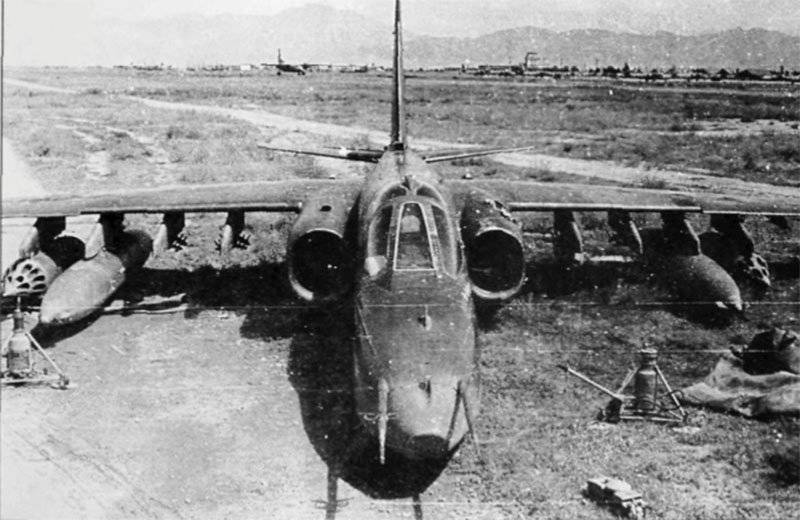
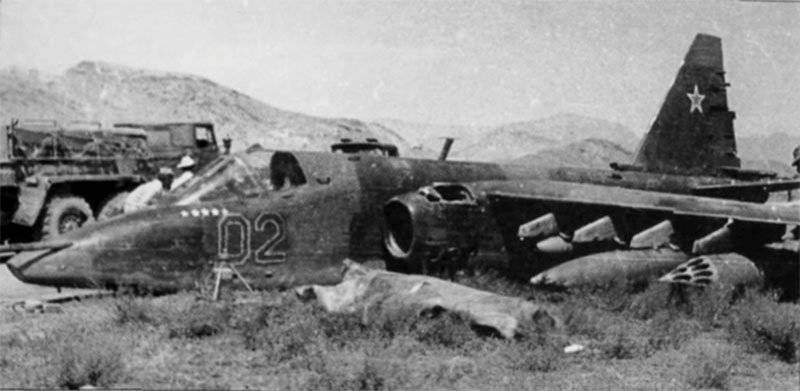
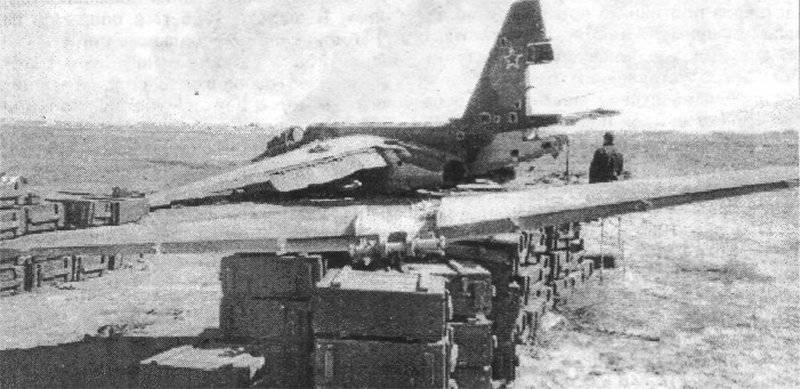
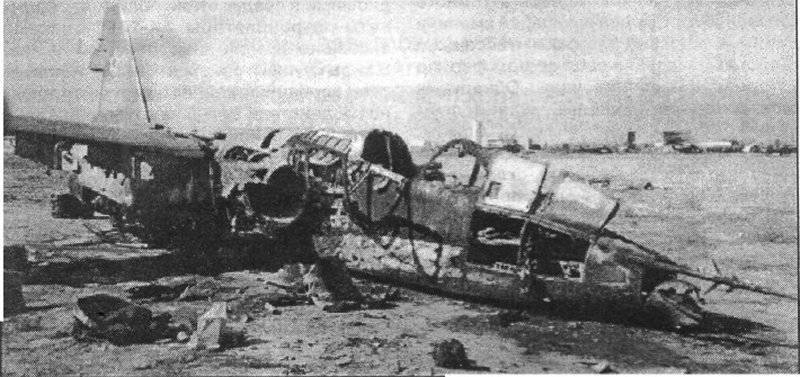
Since the fall of 1985, the “hunt” was conducted even at night, although the Su-25 did not have special aiming equipment. All the improvements were reduced to the installation of the antireflection shield near the landing lights so that they would not blind the pilot. In the moonlit nights in the winter they did without the help of the SAB - on the snow-covered passes and fields any movement was clearly visible, and even trodden trails leading to shelters and overnight stops. Caravans crouching in the dark (camels and horses replaced jeeps, mostly Japanese Nissans and Toyotas) gave themselves off with headlights, which they struck. Having discovered a target in a mountain decay, where it was not easy to lay bombs during the day, the “hunters” practiced a blow with powerful bombs above the slope, which caused a landslide that buried the enemy under tons of stones. The night darkness reliably hid attack aircraft from anti-aircraft fire, but it demanded increased care not to crash into the mountains (for example, in winter, 1985 died at the Su-25 station l. A. Baranov).
Providing wiring of transport columns, Su-25 beat out dushmanskie ambushes from the dominant heights, not allowing them to move forward and fire on the vehicles. From the report of the attack aircraft A.Pochkina: "Acting as a couple along the road north of the city of Gardez, I found on the top of the mountain a rocket launcher with the calculation that was firing at the convoy of tankers, and destroyed it with a single bombing strike." In August, 1985 in the supply operations of the Chagcharan provincial center 250 of the Soviet and several hundred Afghan trucks, accompanied by four motorized rifle battalions, tanks and artillery batteries, covered the 32 of the aircraft and helicopter. Clearing the way for the convoy, in six days they destroyed the 21 firing point and more 130 rebels.
Of particular importance in organizing raids acquired clear leadership and command and control, which required reliable radio communications. Without it, the pilots could not coordinate actions with their neighbors and aircraft gunners. Decreasing, the planes disappeared around the mountains, disappearing from all-round screens and from the air, forcing flight managers to curse: "The Red Army is strong, but communication will destroy it." To ensure uninterrupted radio communications, An-26РТ repeater planes, which hung for hours in the sky over the impact area, began to be lifted into the air. In the course of large operations, when special coordination and preparedness of large aviation groups in a vast area was required (as was the summer of 1986 during the defeat of the arsenal base near Herat), flying IL-22 command posts appeared over Afghanistan, equipped with a powerful onboard control complex and communications capable of ensuring the work of the whole air army. The Su-25 themselves equipped a special EHkalipt P-828 VHF radio station to communicate with ground forces within line of sight.
In connection with the frequent shelling and sabotage from the spring of 1985, the Su-25 began to be recruited to patrol over the Kabul airport and the headquarters of the 40 Army located in the former Amin Palace. Helicopters were on duty at night, and when guard posts reported suspicious activity in the nearby mountains, Su-25 was raised from Bagram. A couple of stormtroopers were constantly on duty in Bagram, whose task was to immediately strike the area where Ahmad Shah Massoud appeared - the number one enemy in these places and the undivided owner Charikar and Panjshir. Skillful and energetic adversary, appointed by the top of the opposition "commander-in-chief of the fronts of the central provinces", Masood caused particular dislike of Kabul for his bold operations under the capital itself and, especially, indisputable authority among the population. The pilot who destroyed Ahmad Shah was promised the title of Hero of the Soviet Union; Turan Ismail, commander of lower rank, respectively, was evaluated by the Order of the Red Banner. Assault and special forces were hunting for Masood, ambushes were organized, troop operations were carried out, no less than 10 times were reported about his death (BVGromov himself believed that "Ahmad Shah was no longer alive from 85, this is only a banner from the opposition ”), but the elusive Amirsaib again and again avoided persecution, learning through their people in Kabul beforehand about the upcoming attacks — among the Masoud informants were top secret officers of the Afghan army and the head of the General Staff Intelligence Directorate himself Major General Khalil (Traitors) Khalil and his officers were revealed in the spring of 1985 g).
The conduct of reconnaissance occupied a relatively modest place among the tasks of attack aircraft (insufficient flight range and the lack of special equipment prevented it) and was limited to visual reconnaissance in the interests of its own unit. In preparation for the raid, the squadron commander or navigator flew around the area of the future strike, getting acquainted with the terrain and landmarks, and just before the attack, the squadron pilots conducted additional exploration. At the suggestion of A.V. Rutsky, who took 1985 of OSHAP on 378 in the fall, one Su-25 was equipped with a photocontainer to record the results of strikes.
The versatility, and in many cases, the indispensability of the Su-25, made their use extremely intensive. In 1985, attack and attack pilots scored twice as many sorties as their Su-17 counterparts, and had an average 270-300 flight time (the “Allied” standard was 100 hours), and many left far behind these figures. A, B .Rutskoy made 453 combat sorties (of which 169 - at night), Art. VF Goncharenko from the 378 regiment had their 415, and Colonel GP Haustov (on all types of aircraft) - more than 700 for Two years of work in the DRA (Marshal of Aviation A.N.Efimov - the renowned attack pilot twice Hero of the Soviet Union for the entire Patriotic War made 222 combat sorties). For the year, there were about 500 departures, but there were also well-deserved Su-25s who had time to fly on a mission up to 950 times. The load on attack aircraft and their wear exceeded all norms, which is why the “shift change” - the transfer of cars to visitors replaced regiments and squadrons. Honestly serving battered planes went home with the pilots.
Among Su-25 pilots, occupational diseases included persistent stomach pain, aching joints and nosebleeds caused by flying at altitude in an unsealed cockpit. These problems were exacerbated by the meager and monotonous food that added the “oaths and hardships” promised by the oath. A normal “food allowance” turned out to be an unsolvable problem for suppliers, and aviators were awaited from day to day by hardened cereals, canned foods and concentrates, which remained the basis of the ration among the abundant greenery and fruits. They didn’t even try to arrange supplies at the expense of local resources for fear of poisoning, and the rear services sold stocks in warehouses to Afghanistan, with which canned bread, canned meat and 1943 rusks were put into flight canteens. nail),
With the increased air defense of the Mujahideen, the Su-25 increasingly began to bring serious damage from the battlefield. Although reliable protection in many cases rescued the pilot, anti-aircraft fire damaged engines, tanks, controls, and disrupted aircraft equipment. Su-25, piloted by V. Bondarenko, returned to the airfield, dragging a plume of kerosene from tattered wings behind him and stopped on the runway without a single drop of fuel. Major A.Porublev's attack aircraft received a DShK bullet in the wing holder's lock, from which the outboard tank fell, immediately strung with a diving plane on the pylon. The plane with a vertically sticking tank managed with difficulty, but no matter how hard the pilot tried, the tank failed to shake off the tank, and with this unusual suspension Su-25 came to the base. Another time on the plane st. Lieutenant Kovalenko simultaneously beat 30 anti-aircraft guns, according to eyewitnesses, "reminding of fireworks in Red Square." During the first year of 378 operation, the 12 pilots once had to return to the airfield with one engine knocked out. Still, attack aircraft suffered losses: there was a case when the Su-25 crashed due to hitting just one bullet that killed the oxygen hose; the pilot lost consciousness, and the unmanaged car fell to the ground. 10 December 1984 was shot down over the Panjsher by Su-25, the senior staff member of VI Zazdravnova, who attacked the target with cannon fire: at the exit of the dive, the response line damaged the command and the plane crashed into the rocks.
The good maintainability and interchangeability of the nodes, prudently incorporated into the design of the Su-25, helped to return the damaged aircraft into service. Holes, flaps, steering wheels, broken landing gear were replaced on the spot, attack aircraft were encountered with completely new nacelles, nose and tail parts of the fuselage. The need for “darning” of numerous bullet and fragmentation holes forced us to recall the plumbing and riveting business that had been forgotten in the front-line parts, and the industry began supplying sets of the most damaged panels and hoods. Due to the abundance of holes (a kind of record was 165 holes on one Su-25), many of them were clumsy clumsily, “on my knee”. Sometimes even duralumin was not enough for repair, and in one of the regiments the attack aircraft carried patches of flattened shells! Another problem was the lack of spare parts, and from time to time one of the most damaged aircraft turned into their source and went "to feed" to their fellow workers who continued to work.
During the 4 th Panjsher operation launched in May 1985 (its goal was “complete and final defeat of the gangs in the central provinces”) the valley covered 200 DShK and ZSU, in addition to which Ahmad Shah detachments received another three dozen 20- mm anti-aircraft guns "Erlikon-Berle" Swiss production with a reach height of 2000 m. They are easily disassembled for transportation and allowed to equip positions in the most unexpected places. Foreign instructors helped to master weapons well, the Mujahideen themselves learned how to build an air defense system around the camps, using the features of the relief to cover the firing points. The saturation of combat areas with anti-aircraft weapons began to pose a serious threat, and neglect of it could not go unpunished: 22 July 1985 g. Su-25 S.V. Shumikhina was above the target for almost half an hour and was shot down at 11-m combat approach, came under fire masked anti-aircraft guns.
Working as a couple, attack aircraft began to distribute duties as follows: the lead attacked the target, and the follower followed the terrain, striking the move with detected “welding” flashes. To protect against fire from above, under which the planes fell in the gorges and turns, the pilots began to receive titanium armored helmets, but the heavy "bowlers" did not take root among the pilots who preferred a good view and freedom of action.
New types of ammunition came to the aid of attack aircraft, combining a high destructive ability with a long aimed range, which allowed them to work on the target without entering the air defense zone. Large-caliber 25-mm B-122L missile blocks with a launch range of up to 13 m were used at Su-4000. They were loaded with high-explosive high-speed explosives. NAR C-13-OB, with power and lethal force superior by C-8 and C-13 with penetrating warhead, penetrated the three-meter layer of earth and stones above the shelters. Heavy NAR C-25-OF and OFM with dvuhsotkilogramovoy warhead "in the teeth" were strong, well-protected structures - the fortress, firing points in the rocks and fortifications. Reliable and unpretentious C-25 with the equipment of the aircraft were no more difficult than conventional bombs. Launch tubes with missiles stacked on the airfields, and for their preparation it was enough to rip the wrapping paper and screw in the fuse. Suspended installations SPPU-22-01 with mobile guns GSH-23 were also used. During the landing on the Jawar base in April 1986, the four Su-25 four with SPPP irrigation fire on the slopes of the gorge cleared the way for the approaching helicopters. Not a single Mi-8 with troops was lost.
In April of the same year, Su-25 Rutskoi and the commander of Vysotsky, attacking the warehouses cut down in the rocks under Khost, first used guided missiles that could be launched from safe distances and heights. When using the X-23 radio command, the pilot found it difficult to find the target himself and control the rocket, watching its flight. Therefore, the X-25 and X-29L with laser homing proved to be the most practical, target illumination with the help of the Klen-PS on-board range-finder target indicator could also be carried out by another attack aircraft, but the best results were provided by a ground gunner who knew the terrain well. At first, ground-based laser designators were mounted on an BTR and BMP improvised, then they were replaced by regular aircraft-guided combat vehicles (BOMAN) based on the BTR-80, on which the system was covered under armor and moved out during operation.
The enemy quickly appreciated the value of unusual-looking cars and tried to shoot them first. After several particularly successful launches, when rockets covered headquarters and Islamic committees, the BOMAN hunt began on the roads and parking lots, forcing to hide cars behind barbed wire and minefields of well-protected airfields.
Rockets have become a reliable weapon for defeating cave shelters that are virtually invulnerable to other ammunition. The Mujahideen used them as warehouses and caches, equipped weapon repair shops (there was a whole ammunition factory in the cave city at the Jawar base). The mountains dug out by holes turned into natural fortresses — dragging out recoilless guns, DShK and mortars to the top, spooks staged firing positions that were closed from shelling from below, and the artillery and tanks could not knock them out. The fire from the high cliffs was destructively precise, and steep slopes and debris didn’t get close to them. When using aviation, the enemy hid in the depths under thick arches, and the bombs and the NAR crumbled the stones around. After waiting the raid, the arrows went outside and continued firing.
Accuracy of hitting the “laser lights” was amazing - the missiles could be laid precisely at the entrances of caves and embrasures, and their massive warhead with excess was enough to destroy the target. Particularly effective was the heavy X-29L with an 317 kg warhead, enclosed in a robust case. Punching a stone, she went into the depths and cracked the most inaccessible objects from the inside. If a caravan of ammunition was hidden in the cave, the success was truly deafening. C-25L, simpler guided missiles, were also used, a variant of conventional NAR, on which a headunit was installed with a control system and a laser seeker of the same type as on X-25 and X-29Л.
The Su-25 rocket attack was vividly described by the commander of the airborne company, pressed to the ground with fire from a dota hanging over the Baghlan gorge: “We couldn’t lift our heads, when suddenly a pair of aircraft flew over us, and then something bright flew into the embrasure between the stones and smashed dot in the gravel. " More often, quite expensive missiles were used on "piece" targets, using intelligence data, carefully preparing each hit. The launches were performed from a range of 4-5 km from a gentle dive at an angle of 25-30 °, the deviation of the missiles from the aiming point did not exceed 1,5-2 m. According to the Sukhoi Design Bureau, the total number of guided missiles in the DRA was made.

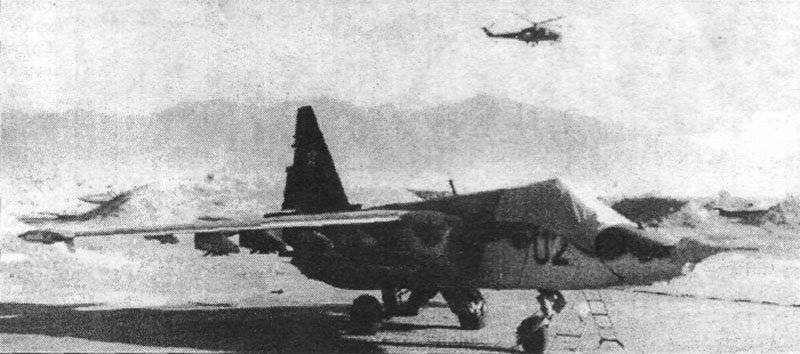
With the advent of the Mujahideen MANPADS, the loss statistics of attack aircraft began to change for the worse. Their first victim was, apparently, a commissar, Lieutenant Colonel P.V. Ruban, shot down by 16 in January 1984, above the town of Urgun. The Su-25 was damaged by the engines and controls, the attack aircraft began to fall, and when the pilot tried to leave the car, the height was not enough. One day, the Su-25 even brought an unexploded rocket out of flight, landing right into the engine and sticking out. By the end of the year, five more attack aircraft were shot down with the help of MANPADS. At this time, the Strela-2M missile systems coming from Arab countries and American-made Red I through Pakistan were used. The English “Bloupip” with radio command guidance and greater altitude (up to 3000 m) also appeared, but did not find widespread use due to the complexity of control and large weight (21 kg in curb condition against 15 kg in Strela and 13 kg in "Red Ay"). Most likely, one of Bloupipe in April 1986, under Khost, shot down AV Rutsky: the plane was already flashed by the ZGU line, when the rocket hit the left engine air intake and turned it off, caused the control system to surge . Barely kept up in the air, the attack aircraft was finished off by the next anti-aircraft gun, and the pilot managed to leave the car falling on its side already above the ground.
To protect against thermal ghosts, the Su-25 was equipped with four ASO-2В cassettes with PPI-26 infrared pyrotechnical cartridges (LO-56), but pilots rarely used them. The control panel of the ASO was on the side of the pilot, and to work with him, it was necessary to be distracted at the hottest moment of the attack. In addition, the trap stock was barely enough for one minute of the ASO operation, and the attack aircraft took care of them in case of emergency, but when they noticed the launch, it became too late to pour the squibs - the GOS seized the target, and the rocket went to the aircraft. In view of the urgency, the problem was solved simply - they installed additional beams ASO-2В on the nacelles, having doubled the number of traps. Now the shooting began automatically with a press of the combat button at the beginning of the attack and lasted for 30 seconds before the end of the combat call. Su-25 began to carry 256 squibs, each of which cost about 7 rubles, and the pilot who made a good "firework" fired 5-6 into the air in this way. The costs were worth it - the pilots were convinced of the effectiveness of the traps when they heard the gaps behind the deceived missiles leaving behind.
The situation was altered by the appearance of the Stingers at the end of 1986 with a highly sensitive selective seeker that distinguished the engine with a characteristic temperature range from a burning trap. "Stinger" had a greater reach in height, could be used on a collision course, and his CU was three times more powerful than the "Red Eye". In combination with the proximity fuze that triggered even when flying close to the aircraft, this made it possible to cause severe damage without direct hit. The reliability of protection with the help of LO decreased, and reports began to note a "tendency to a serious increase in losses from MANPADS." During the first week of use of the Stingers in November 1986, they shot down four Su-25, killing two pilots. By September 1987, the loss amounted to a whole squadron.
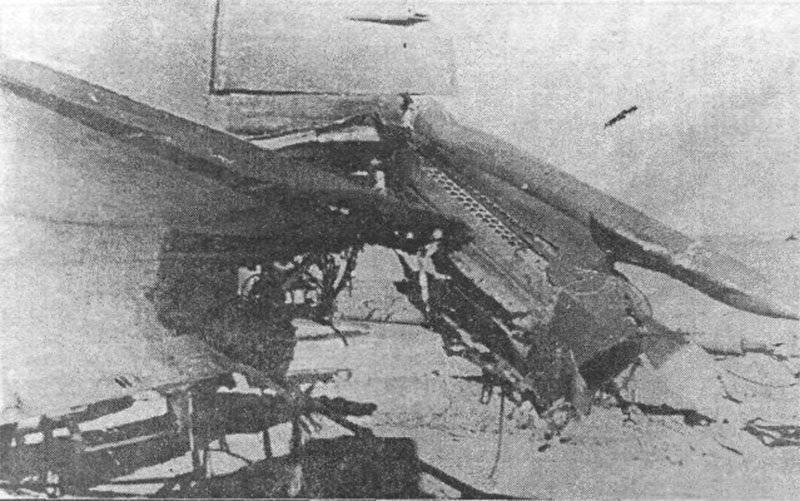
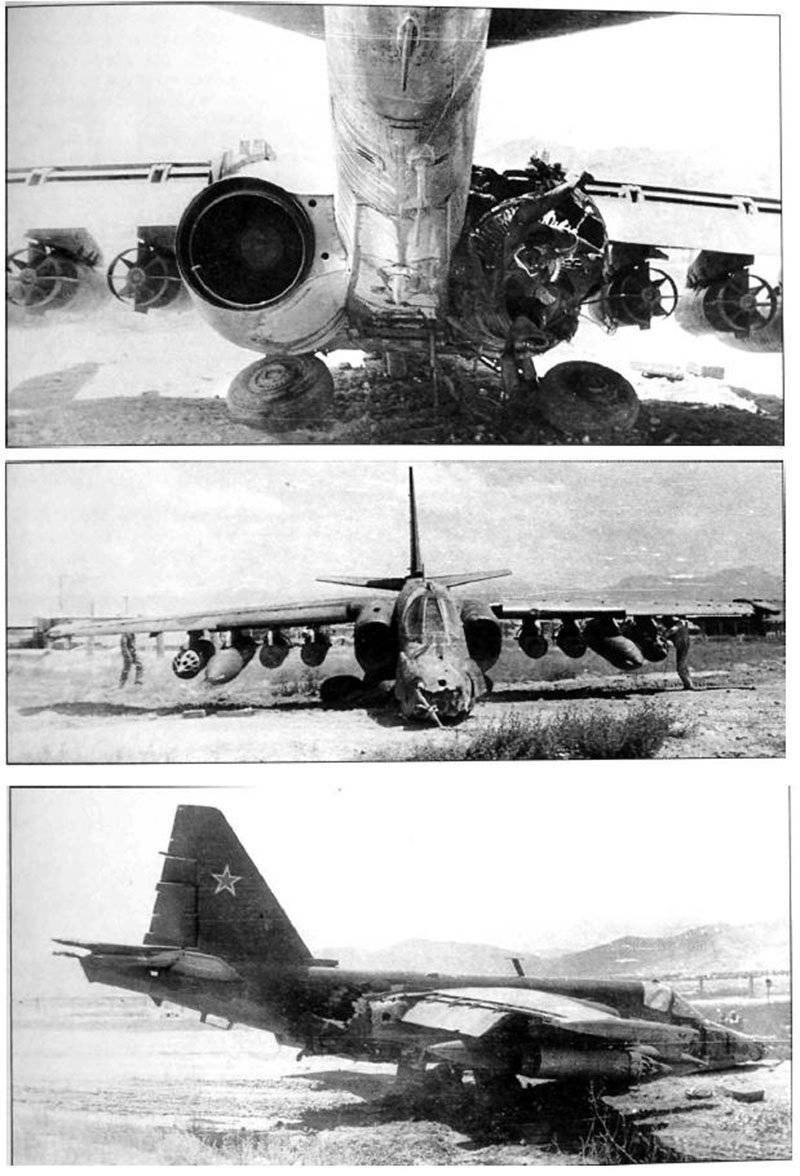
The intention to install the Sukhogruz active jamming station on the Su-25, which jammed the missiles and showed itself well on the helicopters, could not be implemented due to its too much power consumption, and the survivability of the attack aircraft began to be enhanced by more traditional methods - additional protection for the most vulnerable units and systems . The perspectives of the missile approach and fragmentation of the fragments, the most affected nodes, the nature of the damage and their "fatality" were determined by studying damage statistics, the lack of which was not - Rooks often returned home "on parole." Major A. Rybakov (on the eve he had already received an anti-aircraft gun flare in flap) reached the airfield on an airplane with one engine choked, filled with kerosene from a punctured tank, cut by fragments with a flashlight, a completely failed hydraulic system and a non-released chassis. Not a single device worked in the cockpit, and the pilot, with his face covered in blood, led the plane blindly, at the command of his partner. Sitting down on the belly, the pilot rushed away from the aircraft, and only making sure that the explosion did not threaten the car, he returned to turn off the engine that raised clouds of dust.
28 July 1987. An attack aircraft came to the base with a hole in the board, with a right engine smashed by a rocket, a fireball burned out of the fire compartment with a flame from the engine compartment, the electrical fixtures and power assemblies burned out, and the elevator control burned out at 95%. The fire continued until the landing itself, and yet - every cloud has a silver lining - the landing gear itself came out of a short circuit, and the aircraft was able to land.
The Su-25 of P. Golubtsov’s rocket half tore off the tail, but the engines continued to work. The brakes failed, and after landing the plane rolled out over a strip on a minefield, where the pilot had to wait for the sappers to get out. Another plane exploded almost a quarter of a wing from an explosion. On the plane of Lieutenant Burakov, the rocket carried almost the entire keel down to the root, and the pilot managed to land with great difficulty, driving along the course with the help of ailerons. The pilots talked about the strong explosions in the fuselage a few minutes after the fire extinguished in the engine compartments. It was not the tanks that exploded - the sponge filling them extinguished the shock wave and stopped the flames, but the kerosene continued to lash out of the broken pipelines, filling the hot engine.
The chief designer of the aircraft, VP Babac, flew several times to the DRA, and one of the mutilated Su-25 with a torn engine and traces of fire was delivered to the Design Bureau. In most cases, the rockets exploded from the bottom-side of the engine, the collapsed turbine and compressor went astray, and the blades flying in all directions chopped everything in its path worse than fragments. To isolate a damaged engine, to protect the fuselage compartments and fuel fittings from fire, from an airplane, ser. 09077 no. On the sides of the engine compartments between the 18-21 and 21-25 frames, steel 5-mm shielding plates and fiberglass protection mats were installed. Titanium engine control was replaced by heat resistant steel, fuel piping was changed, covering them behind screens, and to prevent explosions during leaks, automatic fuel cut-off was introduced when the fire system was turned on, protecting it from the fuselage tail with electrical equipment and control wiring. For blowing the engine compartment and cooling the nozzles on the engine nacelle installed air intakes. In the complex of modifications, they mounted armored shutters of a lantern and an additional armor plate that covered ASO - there were cases when shooting machines were knocked out with splinters, and the plane was rendered defenseless. The total mass of the Su-25 protection reached 1100 kg, making 11,5% of the mass of the structure. Attack aircraft with increased combat survivability ("Su-25 with PBT") began to arrive in Afghanistan in August 1987.
To reduce the risk of injury from the end of 1986 g, the pilots were forbidden to descend below 4500 m, but this order contradicted the very "style of work" of attack aircraft and was often violated by them. AVRutskoy, according to the characteristic - “a strong pilot and a strong-willed commander”, had two penalties for violating the restriction, and his Su-25 carried 39 holes. For less vulnerability on takeoff and landing, attack aircraft began to use steep trajectories, using air brakes for a sharp decline and almost parachuting into the runway. A go-around was considered to be already a serious fault - enemy gunmen could wait in the nearby "Zelenka". 21 On January 1987, the Su-25 of st. L-that K.Pavlyukov, who took off from Bagram, was shot down by an “Stinger” from ambush. The pilot ejected, but at dusk, the search helicopters could not find him. The wounded pilot took the fight on the ground and, having spent all the bullets, blew himself up with a grenade.
Much of the damage to the combat vehicles accounted for rough landings due to the complexity of the maneuver and the high speed of approach, which required increased attention from the pilots who were returning from the battle and worn out by several sorties. A rare month did without accidents: attack aircraft sat down with a minimal amount of fuel, without releasing flaps and air brakes, touched each other, not having time to turn away from the lane, lose their wheels and demolish the chassis. Known and many cases of folding the front landing gear with too hard touching the runway. The brakes burnt on the landing and the splintered pneumatics were a daily affair and they happened several times a day. October 4 1988 in Bagram sat down to the strip Su-25 demolished all three landing gear racks on its concrete threshold, in a cloud of sparks swept across the belly, and stopped, cramping the fuselage along the very armored cubicle. The pilot, who did not even get bruises, got out of the remains of the attack aircraft and went to "surrender" to headquarters.
The number of Su-25 lost in Afghanistan is usually estimated at 23 machines (out of the total number of 118 aircraft). However, this number requires clarification. It was not always possible to establish the actual causes of the death of an aircraft: in most cases car fragments remained lying far in the mountains, and often had to rely only on the emotional reports of the pilot and his colleagues.

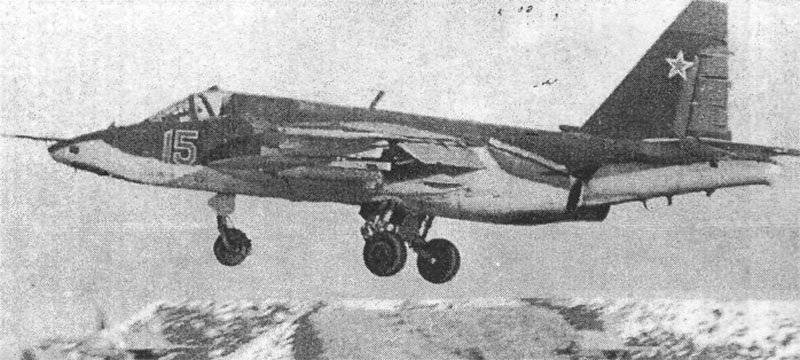
If the accident occurred through the pilot's fault, it threatened him, at a minimum, with suspension from flight work, and there was no need to scatter cadres in a combat situation, and they tried to carry out damage under the “combat” column. The same applied to accidents that occurred due to design-production flaws. It was not easy to prove the guilt of the industry - it was necessary to draw up an accident investigation report, and it was often impossible to inspect the crashed car and really examine the failed units.
When the hopelessness of the protracted war became apparent, the new commander of the 40 Army, BV Gromov, in anticipation of an early withdrawal of troops, set the task: to reduce losses, to minimize the combat activity of ground troops, if possible, refrain from offensive operations and roads and airfields. For aviation, this meant the addition of work: without its help, many garrisons, surrounded on all sides by the enemy, could no longer hold out. For example, in the province of Baghlan, the Soviet amphibious battalion subjected to constant attacks held a plot of only three square kilometers at the crossroads, while it was considered that the province was "partially controlled by the opposition."
To reduce losses, the Rooks have become more widely used for nighttime beats. At the same time, the effects of air defense were almost completely eliminated, and there appeared a real opportunity to destroy large groups of the enemy, which were located overnight in fortresses and villages, on a tip. (Needless to say, what was the fate of the village itself — Rutskoi estimated the situation this way: “But to hell with them, your village or someone else’s, they are all the same on top”). Assault attackers helped Su-17, illuminated terrain SABami. In one of the night raids, the commander of the assault squadron noticed the lights below and immediately covered them with bombs. When he returned, he reported about “dushman's bonfires” and led the entire squadron to the specified area, which inflicted two BSHU “five hundred” and RBC. The paratroopers, sent in the morning to evaluate the results of a night attack, saw only the slopes dug up by the bombs and the dormant bushes set on fire by the SAB. On another occasion, the Su-25 pilot, who was unable to find a target in the dark, dropped bombs at random without risking to land with dangerous cargo. Soon the congratulations to the young pilot, who successfully covered a whole gang of several dozen people who spent the night in this place, came to the unit.
With the beginning of the withdrawal of troops and the departure of the garrison from Kandahar, the storm troopers redeployed to Shindand and Bagram. Another squadron was based at the Kabul airport. The Su-25 tasks were supplemented by the outposts of escaped columns and regular warning strikes along the roads: according to intelligence data, up to 12 thousands of militants and more than 5 thousands pulled up to the Shindand-Kushka road (on average, 20 people every kilometer of the way). Since September, 1988 attack aircraft from Shindand almost every day worked in the area of Kandahar, where the Soviet battalion continued to defend the airfield under continuous shelling. A break at the paratroopers came only with the appearance of the Su-25 in the sky. Under their cover, transport aircraft from the "mainland" delivered ammunition, food, and took the dead and wounded away. The shelling that had become commonplace (1988 rockets fell on Kabul in 635 only) did not bypass the attack aircraft. On a June night in Kandahar, a rocket hit the Su-25 just received from the factory, with eight C-24s hanging under its wing. It was impossible to extinguish it - an ammunition set exploded in the fire, the chair worked and flew away, traps flew away, with a hiss went into the darkness of the rocket, stripping the metal flooring of the parking lot with stabilizers. At the next artillery attack on Kabul Airport in September 1988, X-NUMX Su-10 burned in parking lots and two more cars were seriously damaged. In total, over the last year of the war, the attackers lost 25 airplanes from the air defense of the Mujahideen, shelling airfields and in flight accidents. The last two Su-16s were destroyed in January, 25. One of them, on the way to Shindand, refused an engine, the pilot ejected and was rescued, another Su-1989 was shot down by a rocket over the village of Pagman near Kabul, its pilot was killed. Total for the Afghan war did not return from the battle 25 air attack pilots.
Closing the Afghan epic, Su-25 took part in the 23 1989, which began on January 92, in Operation Typhoon, a series of massive strikes aimed at "causing as much damage to the opposition forces in the central and northern regions of the country." On the eve, senseless battles were stopped by concluding a truce with local elders and Ahmad Shah. Masud promised that he would not touch a single outgoing Soviet soldier, and his people even helped to pull cars stalling in snowdrifts (they also reported cases of “drinking together with Akhmadshahovs” “kishmyshovki”). And yet, finally, “Shuravi” decided to show strength - the most powerful shelling of roadside areas was fired, tactical missiles “Luna-M” were fired at 24 squares, and the aircraft for January 25-600 performed more than 46 sorties and inflicted XNUMX BSHU that ground the surrounding mountains and manners . Masood did not respond to the fire, and in the last days of January, the attack aircraft left the Afghan airfields.
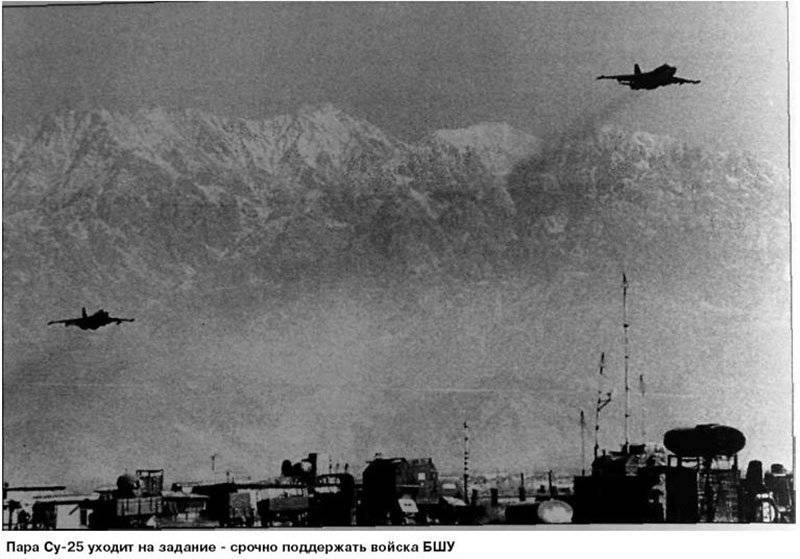
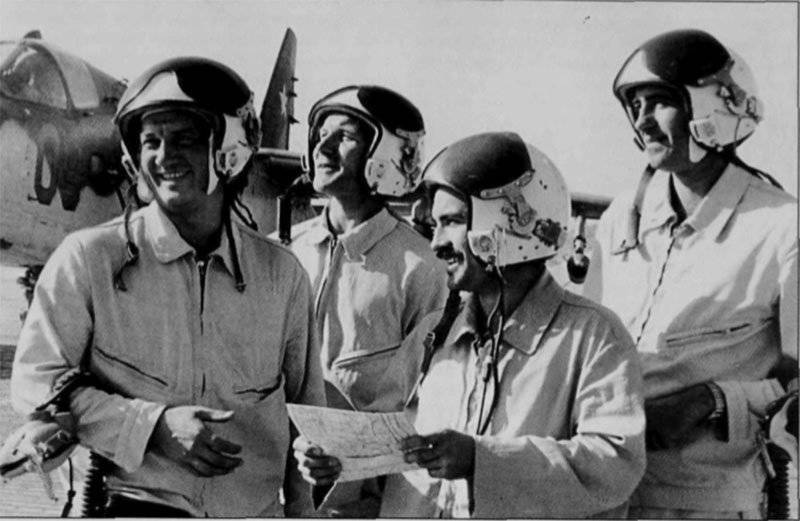
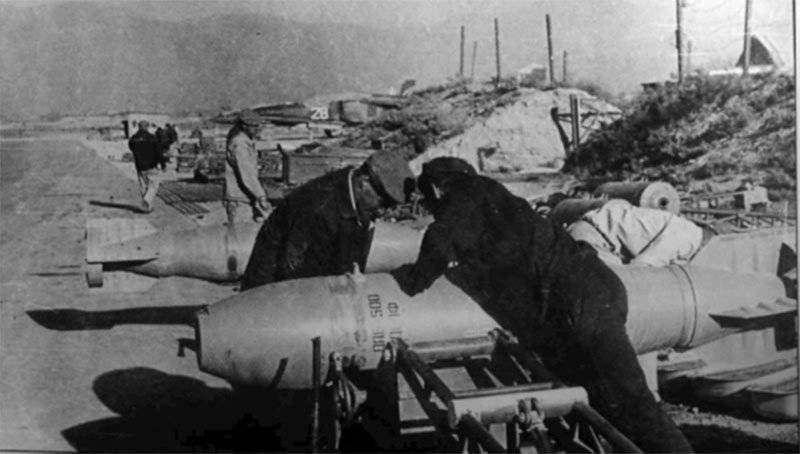
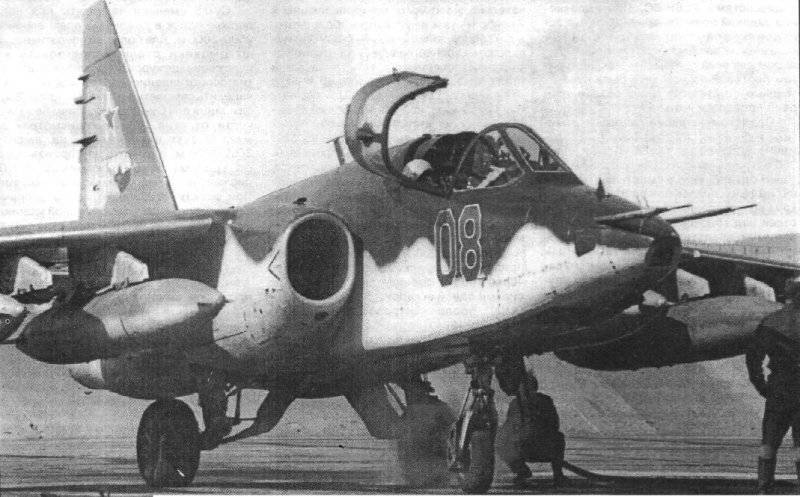
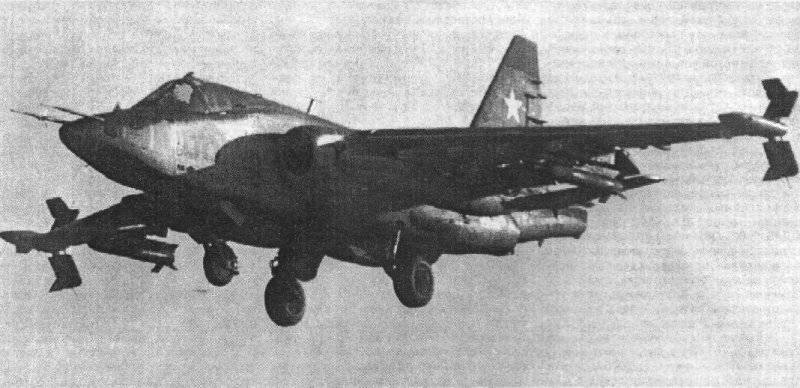
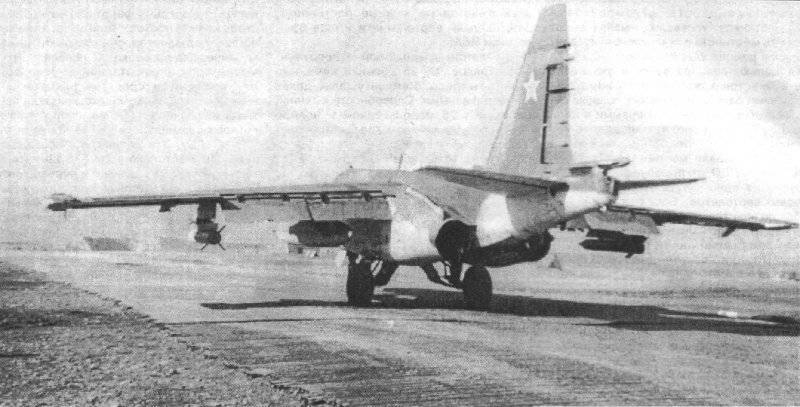


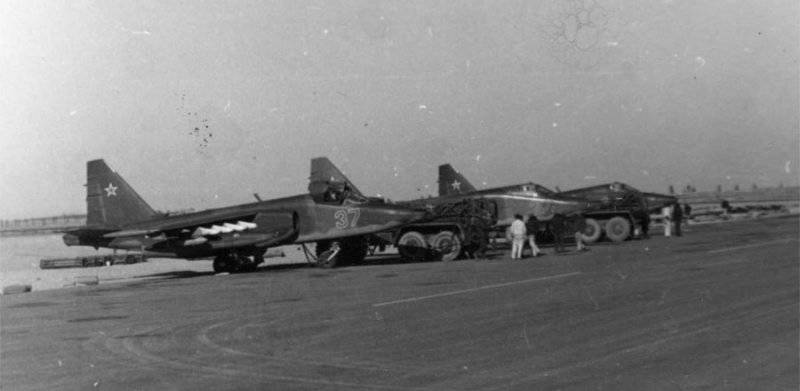
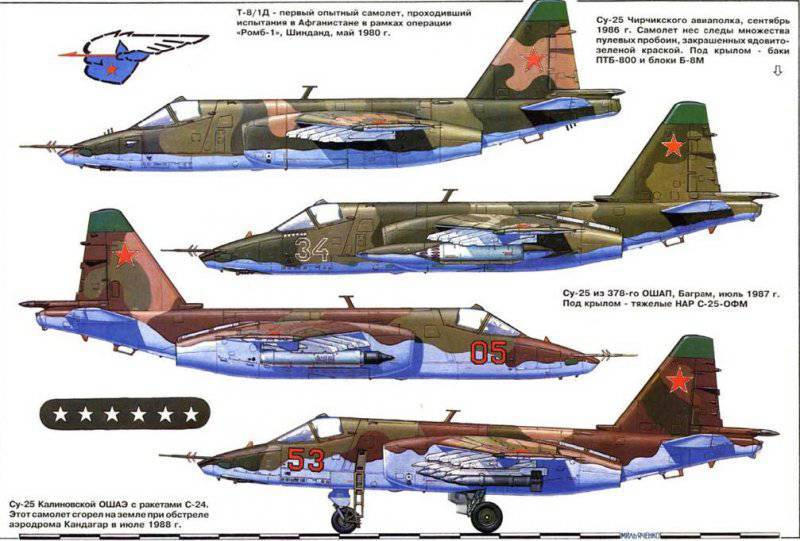
Information